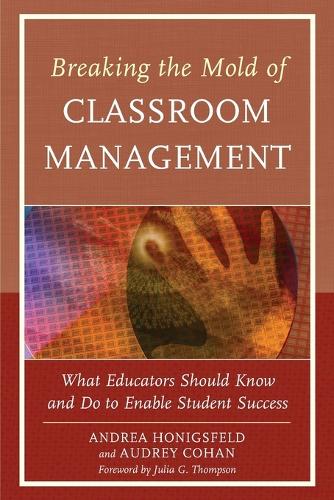
Breaking the Mold of Classroom Management: What Educators Should Know and Do to Enable Student Success, Vol. 5
(Paperback)
Publishing Details
Breaking the Mold of Classroom Management: What Educators Should Know and Do to Enable Student Success, Vol. 5
By (Author) Andrea Honigsfeld
By (author) Audrey Cohan
Foreword by Julia G. Thompson
Bloomsbury Publishing PLC
Rowman & Littlefield Education
11th December 2013
United States
Classifications
Professional and Scholarly
Non Fiction
371.1024
Physical Properties
Paperback
206
Width 153mm, Height 225mm, Spine 13mm
286g
Description
Classroom management is often perceived as the most overwhelming challenge faced by new teachers; it may also continue to confront more experienced educators as they encounter a new group of youngsters or face a new set of demands. Successful classroom management is invariably tied to student engagement and empowerment: teachers who are singled out for excellent classroom management practices are often praised for successfully maintaining a strong instructional focus in their classes coupled with high levels of student motivation. The contributors offer classroom-tested strategies and timely advice on how to create such an effective and supportive instructional environment for academic and social-emotional learning for all.
Similar to the previous four volumes, Breaking the Mold of School Instruction and Organization: Innovative and Successful Practices for the 21st Century (2010), Breaking the Mold of Preservice and Inservice Teacher Education (2011), and,Breaking the Mold of Education for Culturally and Linguistically Diverse Students (2012), and, Breaking the Mold of Education: Innovative and Successful Practices for Student Engagement, Empowerment, and Motivation (2013), the purpose of this book is to offer a carefully selected collection of documented best practices and practical, classroom-tested strategies for immediate implementation
Reviews
Classroom management issues are a constant topic of discussions in this reviewer's graduate courses despite the course focus on teaching and planning effective reading instruction. Furthermore, classroom management issues continue to be one of the reasons why many novice teachers leave the classroom in their first three years of teaching. Editors Honigsfeld and Cohan provide educators with 20 brief yet concise chapters addressing a wide spectrum of classroom management issues. Written by respected educators known for their expertise in classroom management, the chapters provide readers with down-to-earth yet research-based strategies, practices, and perspective that can be implemented tomorrow. Just as important, this text reminds readers that maintaining respect for students and creating environments for positive self-worth are critical components to effective classroom management. Moving from traditional topics surrounding classroom management, this book also offers readers insight into management of online classrooms, cultural issues leading to challenging classroom management situations, and administrative perspectives at the district and building level. Breaking the Mold of Classroom Management is an excellent resource for preservice and veteran teachers as well as teacher educators. Summing Up: Highly recommended. Upper-division undergraduate, graduate, research, and professional collections. * Choice Reviews *
This fifth book in the Breaking the Mold series addresses classroom management from a 21st Century perspective. It is a valuable resource not only for pre-service and newly-hired teachers, but for all teachers who are committed to creating vibrant learning environments where active student engagement, high expectations, a collaborative spirit, and a culture of respect permeate the atmosphere. The practical strategies presented in the book will assist teachers in transitioning from controlled learning environments to classrooms where shared leadership is evident.
As the roles of leaders and learners blur within a classroom and the borders of classrooms blend into a larger learning environment, this resource will provide valuable guidance to teachers, learners and leaders on all levels.
The importance of integrating voice and choice into effective learning environments is emphasized throughout the book. A focus on individual needs (academic and social) within a collaborative setting helps highly effective teachers promote student success. The active engagement of students in lesson design, assessment and interpersonal relations is also a cornerstone of the highly effective classroom. The practical suggestions presented by the contributors of this book will help teachers develop practices to support the establishment of these elements within their classrooms.
Breaking the Mold of Classroom Management makes a much-needed contribution to the educational field. The authors correctly target classroom management as one of the most vexing issues for teachers. Through highlighting innovative teaching practices in a wide variety of contexts, backed by solid theoretical support, the book extends our understanding of how best to manage the classroom. A particular strength is the book's attention to classroom management not only in the classroom, but also in the hallways and online. I appreciated also acknowledgment of trust, caring, and respect as important considerations for supporting positive classroom management. -- Thomas G. Reio, Ph.D., Associate Dean of Graduate Studies, College of Education, Florida International University
Breaking the Mold of Classroom Management blends thoughtful research and effective practice with the accessibility and believability of lived experiences in 21st century K-12 classrooms. In this volume, a diverse array of scholar-practitioners offers something for anyone seeking clarity on progressive approaches to classroom management. -- Marlon C. James, Ph.D., Loyola University, Chicago, IL
Author Bio
Dr. Andrea Honigsfeld is a professor in the division of education at Molloy College, Rockville Centre, NY. She received several awards including a Fulbright Lecturing Award, Outstanding Dissertation Award, and ESL Educator of the Year Award.
Dr. Audrey Cohan is a professor in the division of education at Molloy College, Rockville Centre, NY. She has published on child sexual abuse and effective professional development practices.
